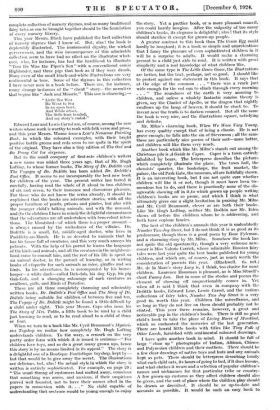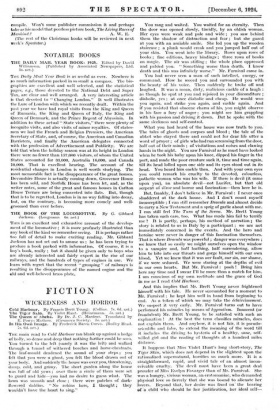CHRISTMAS BOOKS FOR THE NURSERY *
I SUPPOSE that most people assume that " nursery classics " are classics only in the loose sense in which the word is often used in English, when it hardly means more than " old favourite." But though " classic " is not perhaps quite the word we ought to use of them, there does exist a very distinct aristocracy among the books that children like. There are only a few of these aristocratic books. Like cream, they come in a tiny stream from the separator, the rare and exquisite product of many gallons of milk.
The best rhymes and fairy tales are, of course, classics in that sense. " The Jolly Tester," " The Little Man and His Gun," "Pussy Cat, Pussy Cat," and "The Old Woman Who Lived in a Shoe," and in the select company I would include Grimm, the old English fairy tales, indeed almost any traditional stories, but not the delightful but synthetic "Hans Andersen." A • Mother Goose's Nursery Rhymes. By L. Edna Walter. [Black. Ss. MI— Dr. Dolittle's Post Office. By Hugh Lofting. [Cape. 7s. 6d. net.]--The Story of Mrs. Tubbs. By Hugh Lofting. [Butler and Tanner. as. 64.1—When We Weis Very Young. By A. A. Milne. [Methuen. 78. 1)&]—The Little Grey Goose. By Feliche Lefevre. [Grant Richards. 2s. ed.1—The Owl and the Pussy Cat. By Edward Lear. [Warne. 6d.1—The Mysterious Toyshop. By Cyril W. Beaumont. [Beaumont. bs.J—The Green Egg. By A. and M. H. [2s. 64.1—Nuntber Two Joy Street. [Blackwell. 68.1—A Guide to Caper. By Thomas Bodkin. [Chatty and Windus, 5s.]—Lear's Nonsense Painting Book, [Warne. ls, thlj
complete collection of nursery rhymes, and as many traditional fairy tales as can be brought together should be the foundation of every nursery library.
This year Messrs. Black have published the best collection
of nursery rhymes that I know of. But, alas ! the book is
deplorably illustrated. The immemorial dignity, the wicked perverseness, and the wise inconsequence of this admirable
collection seem to have had no effect on the illustrator what- ever, who, for instance, has had the hardihood to illustrate
`` Torn He Was the Piper's Son" with a conventional comic Highlander, and three pigs that look as if they were drunk. Many even of the small black-and-white illustrations are very
sentimental in tone. Some of the rhymes in this collection I have never seen in a book before. There are, for instance, ninny strange instances of the " cheat " story—the narrative that begins like " Jack and Minorie." This one is charming :— " Little Tee Wee He Went to Sea In an open boat, And While afloat, The little boat bended.
And my story's ended."
Edward Lear and Lewis Carrol are, of course, among the rare
writers whose work is worthy to rank with folk verse and prose, and this year Messrs. Warne issue a Lear's Nonsense Painting Book, in which the coloured examples, with their bright positive bottle greens and reds seem to me quite in the spirit of the original. They have also a tiny edition of The Owl and the Pussy Cat for sixpence.
But to the small company of first-rate children's writers
a new name was added three years ago, that of Mr. Hugh Lofting, to whose former books, The Stony of Dr. Dolittle and The Voyages of Dr. Dolittle has been added Dr. Dolittle's Post Office. It seems to me incomparably the best new book for children of the year. The present writer has tested it
carefully, having read the whole of it aloud to two children of six and seven, to their immense and clamorous pleasure.
For those who do not know the series already, it should be explained that the books are adventure stories, with all the proper furniture of pearls, prisons and pirates, but also with
the younger child's talking animals, and with the unusual, and (to the children I have in mind) the delightful circumstance that the adventures arc all undertaken with benevolent inten-
tions. The bloodshed—of which there is a proper amount— is always caused by the wickedness of the villains. Dr.
Dolittle is a small, fat, middle-aged doctor, who lives in Puddleby-on-Marsh. He is so devoted to animals that he has his house full of creatures, and this very much annoys his
patients. With the help of his parrot he learns the language of the birds and animals, and all the creatures in the neighbour- hood come to consult him, and the rest of his life is spent as an animal doctor, in the pursuit of learning, or in writing books of etiquette for such animals as mice, giraffes and sea birds. In his adventures, he is accompanied by his house- keeper—a white duck—called Dab-dab, his dog Gyp, his pig Gab-Gab, and a changing entourage of such creatures as swallows, gulls, and Birds of Paradise.
These are all three completely charming and admirably written books, Dr. Dolittle's Post Office and The Story of Dr. Dolittle being suitable for children of between five and ten. The Voyage of Dr. Dolittle might be found a little difficult by a child under eight. This year Messrs. Cape also issue his The Story of Mrs. Tubbs, a little book to be read by a child
just learning to read, or to be read aloud to a child of three or four.
When we turn to a book like Mr. Cyril Beaumont's Mysteri- ous Toyshop we realize how completely Mr. Hugh Lofting understands children. To the wary, a remark on the very pretty order form with which it is issued is ominous—" For
children love toys, and so do a grea=t many grown ups, hence this story is by no means limited in its appeal." The story is a delightful one of a Boutique Fantistique toyshop, kept by— but that would be to give away the secret. The illustrations are delicious, but, alas ! the actual style in which the story is written is entirely sophisticated. For example, on page 29 : " The usual throng of customers had melted away, conscious that something was amiss, and anxious, if their suspicions proved well founded, not to have their names cited in the papers in connexion with it. . " No child capable of understanding that-senceooe wortkl- be young enough to enjoy
the story. Yet a prettier book, or a more pleasant conceit, you could hardly imagine. After the vulgarity of too many children's books, its elegance is delightful ; alas ! that its style should sterilize it except for grown-up people.
A greater contrast to this book than The Green Egg could hardly be imagined; it is a book so simple and unpretentious
that I fancy the pleasure of even sophisticated children in it will be a surprise to adults. It would make a charming present to a child just able to read. It is written with great simplicity and a real knowledge of what children like.
Of the same type is The Little Green Goose, the illustrations arc better, but the text, perhaps, not so good. I should like
to protest against one statement in this book. It says that at the edge of the common . . . " there was a crack just wide enough for the red sun to climb through every morning . . . " The roundness of the earth is very amusing to children, and unless a wholely fantastic sunrise theory is given, say the Chariot of Apollo, or the dragon that nightly swallows up the lamp of heaven, it should be stuck to. To invent near the truth is to darken counsel. But all the same the book is very nice, and the illustrations square, satisfying and definite.
Mr. Milne's charming book, When We Were Very Young, has every quality except that of being a classic. He is not
grave enough ; he falls into the sin of Stevenson ; all the same these are particularly nice poems of their sort—none better, and children will like them very much.
Another book which like Mr. Milne's stands out among the Christmas pile is A Guide to Caper. Caper is a town entirely inhabited by bears. The letterpress describes the pictures
which completely illustrate the place. The town. hall, the chemists' quarter, the bookshops, the fruit market,, the palace, the old Park Gate, the museum, all are faithfully shown.
It is an interesting book, but I am not quite sure whether children will like it or not, though it must have been. tre- mendous fun to do, and there is practically none of the dis-
agreeable showing off in it,to which grown up people writing
children's books are so prone, and which I think is what ultimately gives one a slight hesitation in praising Mr. Milne
and Mr. Cyril Beaumont, clever as are both their books. Like Mr. Hugh Lofting, neither Mr. Bodkin nor Mr. Eden shows off before the children whom he is addressing, and both have copious fancies.
The best of the children's annuals this year is undoubtedly Number Two Joy Street, but I do not think it is as good as its
predecessor, though there is a good poem by Rose Fyleman, and a charming story by Mr. Milne. Somehow the book has not quite the old spontaneity, though a very welcome new- comer is Miss Valerie Carrick, whose admirable Russian fairy tales were last year quite the best books published for young children, and which are, of course, just as much worth the consideration of parents this year. (Blackwell. 6s. net.)
Mr. de In Mare's story Lucy is, I think, too elusive for most children. Laurence Housman is pleasant, as is Miss Sitwelrs short Funny Loo. But in some of the stories and poems the clement of showing off unquestionably comes in. Yet when all is said I think that even in company with the
Dolittle books, Edward Lear, Lewis Carrol, and the various
collections of fairy tales, Number Two Joy Street is a very good 6s. worth this year. Children like miscellanies,, and
as long as they do not live on. them should probably not be stinted. This year there remains, however, a great and noticeable gap in the children's books. There is still no good
child's book to take the place of Living Races of Mankind, which so enchanted the nurseries of the last generation. There are horrid little books with titles like Tiny Folk of Other Lands, furnished with sentimental coloured drawings.
I have quite another book in mind. It should be full of large " close up " photographs of Indian, Afcican, Chinese
and Polynesian children and their mothers. There should be a few clear drawings of native toys and huts and any animals kept as pets. There should be letterpress describing briefly what each child eats, its hours of going to bed, if it does lessons, and what clothes it wears and a selection of popular children's names and nicknames for that particular tribe or country.
A few grown-up customs as they affect children should also be given, and the sorb of place where the children play should be drawn or described. It should be as up-to-date and accurate as possible. It would be such an easy book to
compile. Won't some publisher commission it and perhaps take as his model that peerless picture book, The Living Races of Mankind ? A. W. E. (The rest of the Christmas books will be reviewed in next week's Spectator.)




















































 Previous page
Previous page